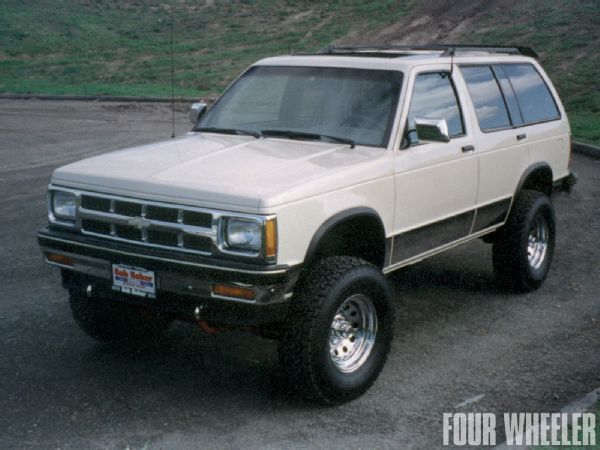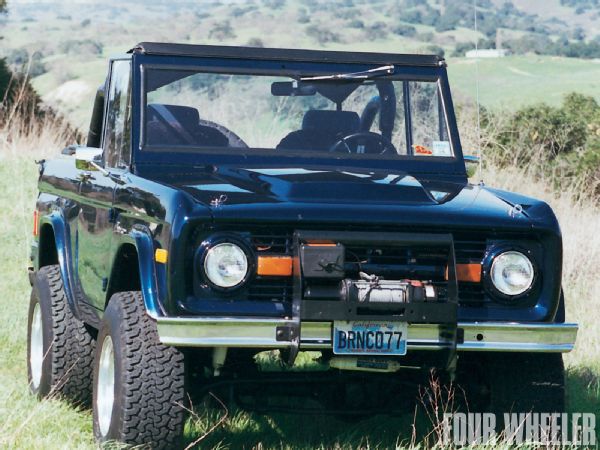
Wants To Build S-Blazer for Sand
I have a ’93 S-10 Blazer two-wheel drive. I’m going to tear it down and make it into a weekend play toy for Glamis dunes and medium-difficulty trail riding (no hardcore rockcrawling). I know what you’re thinking—sell it and buy a four-wheel drive. That doesn’t apply here, as I am going to do a solid axle front and change the transmission from the 4L60-E to a Turbo 350 with a manual valvebody (better for the sand).

My questions are: Would a Dana 44 be strong enough—I don’t plan on running anything bigger than a 35-inch tire—and which application would be best? I don’t necessarily want a D44 out of a fullsize truck because of how wide it will stick out, but Jeep versions have the pumpkin on the wrong side. If I do get a Jeep Dana 44, what transfer case can I bolt to the 350 to make it work out?
Do you think the stock rear 10-bolt would hold up to spinning paddle tires, or should I just upgrade to a 9-inch and not spend money on the locker for the 10-bolt? I won’t be doing any jumping in the dunes like a Trophy Truck, but I want to build it right as I’m on a tight budget and want to do as much as I can with junkyard parts.
Bruno Michel
Mesa, AZ
You might start by taking a look at Sky Manufacturing’s website (www.skymanufacturing.com) as they have a hanger kit for the front leaf springs that will make it a lot easier.
If you have not yet decided what transfer case to use, it doesn’t make a bit of difference which side the pumpkin is on. You can pick a t-case accordingly to match. Nothing is going to directly bolt to your 350 trans without some sort of adapter. The Dana 300 or even a Dana 20 are passenger-side front outputs and would work just fine. The 4x4 versions of the S-10 used either a NP207 or a NP235. Maybe the easiest conversion would be to find a trans/transfer case combination already mated together. These have a driver’s side front output shaft.
Tires at 35 inches would be perfect, and limiting your tire size means you can keep the suspension/body height to a minimum which will make a better handling machine, especially in the sand. In reality, I would probably use a tire closer to 33 inches as you can set the truck even a bit lower without tire/fender interference.
A Dana 44 would work just fine and is plenty strong for your intended use. Most likely, it would be my choice. ) has one. You might even want to upgrade with a set of 44-size axles for insurance against breaking one of the smaller stockers.
Sand is pretty forgiving as far as breakage goes. I think that the 10-bolt would also work okay as long as you don’t get too crazy on the size of the paddle tires. A better choice would be a 12-bolt or Ford 9-inch, or even a Dana 44. Be sure to talk over your tire needs with one of the sand tire suppliers, and to get the right “cut.” I would think something like a 16.50 Padla Trak would be about all the tire you would need for the sand, and they are about 33 inches tall. Check out www.sandtiresunlimited.com for more info.
As to running a locker either in the front or rear, for the sand I am not sure one in either end is necessary. If it is only a toy and doesn’t get driven on the street, consider a spool out back and leave the front open. I have put a lot of “sand time” in with vehicles with both open diffs and lockers, and both have their advantages as well as disadvantages.
Oh, and you might want to take a look at www.s10extremist.org, as it appears to have a lot of interesting information on your truck.
One of the real tricks to dune running is keeping the vehicle light; so forego the heavy winch/bumper, and if you feel that you need a winch for trail running, make sure you can take it off for the sand.
Dual Heaters for Soft-Top Bronco?
I am running a soft top on a Bronco year-’round. I resealed the original heater box and replaced the air ducts, and it functions fine. I have been doing some research on auxiliary heaters, and have found articles and reviews about Heater Craft (Moab) and Mojave heaters from Flex-a-Lite. My intent is to have two heaters run in series, I guess. Will that cut output so much neither heater will function well?
Steve Paterson
Billings, MT

The whole secret to a warm interior, or good heater output, is water temperature. I think that one heater would be sufficient for most instances if you can maintain engine water temperature in the 200-degree range. Naturally, good flow through the heater core is very important, so the core must be in very good condition with no calcium buildup in the tubes. This means you may have to (1) have the core cleaned at a radiator shop, or (2) buy a new core. Blower output is also important, as you really need to move a large volume of air over the heater’s core
As to using two heaters, yes, this is very possible. You would have to devise some way to run the hot water to each heater unit. If you tried to run it through one heater and then to the second one, most of the heated water would be lost and the second heater would have very little output. The difficulty comes with finding a mounting location and safely running the two hoses to it. If the length of the hose run is long, such as to under the back seat, you’ll probably need some way to insulate the hoses to prevent heat loss before it reaches the heater core.
I have used the Heater Craft heater in my softtop flatfender, and it worked excellently, providing all the heat we generally needed; however, we never used the Jeep in below zero-degree weather.
You might want to take a look at the heaters offered by Danhard (www.Danhard.com); they have a pretty extensive line-up of high output heaters in various sizes. In fact, I just installed their model 1412 in my new flatfender.
Wants OD Transmission for Older 360 V-8
I own an ’87 Dodge Ramcharger 4x4 with a 360 V-8 and TorqueFlite 727 transmission. Is there an automatic overdrive tranny that can be bolted in place of the TF727 so I can lower my highway rpm and hopefully improve mpg. The truck has stock gears, and I run 33-inch Firestone Destination mud-terrains. The truck was supposed to be used for hunting and fishing, but it is a lot more fun as a daily driver than my Taurus.
Emilio Balli
Harlingen, TX
As I look at it, there are a couple of ways you can do this to gain some higher gearing and not hurt off-road performance. The first is to swap transmissions. This can be pretty simple using an A518 or an A618 transmission. I came up with a wiring system for it at www.transmissionconter.net.
The spline count is probably the same. As far as the length it sticks out, I have no idea. This swap will only work with the early-style A518/618 transmissions. They came in two-wire non-lock-up and three-wire lock-up versions. This swap would not be worth it in my eyes if you were not using a three-wire lock-up for rpm reasons. I don’t know about transfer case compatibility, I only know that “some” early Dodge diesels that had the 618 used the NP 205 with a round pattern that dropped to the passenger side. There are different switches for different speeds that control where you want lock up in Fourth to apply. Then, when you accelerate, vacuum and throttle pressure will override and downshift.
An RE-series transmission out of a ’95-and-newer Dodge will require a totally different approach to use for a swap. You will need a lot of time to figure out wiring and computer swapping. Perhaps some aftermarket company may produce a stand-alone computer system; perhaps an Internet search on the subject will produce some information. The older A518/618s still have a mechanical governor, and only Fourth gear and lock-up. Transmission guys tell me that these early Dodge overdrives are not the greatest transmissions without lots of help (i.e., a very updated rebuild).
Your other choice is to consider adding an auxiliary gearbox such as is available from Gear Vendors (www.gearvendors.com). They are pretty expensive, so it will take quite awhile for payback on just mileage savings. However, there will be less wear on the engine resulting from the lower rpm,, and you will be able to turn your three-speed into a six-speed trans. In top gear, it will be like going from a 4.11:1 gear set to a 3.20:1 gear.
Wants 8 on 6½ Bolt Pattern for Sterling 10.5
I have a Sterling 10.5-inch rearend with the 8x170 metric bolt pattern. I’d like to switch it to the 8-on-6½ pattern without using a wheel spacer. I know that the 10.25 had an 8-on-6½ pattern. Is it possible to switch just the hubs so that I can get this bolt pattern? I do realize I’ll have to run different discs and do some fabrication to make it work.
Michael Howe
Roseville, CA
From what I know about the Sterling rearend, and it is very little, is that it seems that the 10.25s with the 8-on-6½ bolt pattern had drum brakes. However, it seems that the shafts are different lengths between the 10.25 and the 10.5. The spindles are shorter on the 10.5, and so are the hubs. The 10.25 studs are bigger and have a finer thread, and strange as it sounds, the 10.25 bearings are a lot bigger than those of the 10.5.
It seems the only way you’re going to get the non-metric bolt pattern is to re-drill the hubs and rotors. I’m not sure if there really is enough room to do this without weakening the hub, so the metric holes may have to be welded up. But then again, maybe not. The more I looked into it, I began to hear rumors that ’99-and-up E-series Ford vans used the disc brakes and had a standard bolt pattern. A check with All Data showed that yes, indeed, the vans had disc brakes, but I couldn’t find any information as to bolt pattern. An interesting thing about the vans is that some had Dana 70s instead of the Sterling. Go figure.
Where To Write
Address your correspondence to: Four Wheeler, 831 S. Douglas St., El Segundo, CA 90245. All letters become the property of Four Wheeler, and we reserve the right to edit them for length, accuracy, and clarity. The editorial department can also be reached through the website at www.fourwheeler.com. Due to the volume of mail, electronic and otherwise, we cannot respond to every reader, but we do read everything.